
Alperce, mirabela, ameixa e ameixa seca
modelos de doenças
Doença da ferrugem
Pathogen
O agente patogénico fúngico Tranzschelia discolor infecta plantas do género Prunus, incluindo amêndoas, damascos, cerejas, pêssegos, nectarinas, ameixas e ameixeiras. O fungo é classificado em formas especializadas com base no seu hospedeiro: T. discolor f. sp. persicae em pêssego, T. discolor f. sp. dulcis na amêndoa, e T. discolor f. sp. domesticae na ameixa.
O agente patogénico passa por várias fases de esporos e necessita de dois hospedeiros distintos (hospedeiros alternativos) para completar o seu ciclo de vida. Na Califórnia, o único hospedeiro alternativo confirmado é Anémona coronária (Ranunculaceae). Os diferentes tipos de esporos incluem urediniósporos, teliosporos, basidiósporos e aeciosporos, embora apenas os urediniósporos e os teliosporos ocorram em espécies de Prunus.
Os urediniósporos unicelulares de cor castanha enferrujada são produzidos no pêssego e podem causar infecções secundárias, conduzindo a ciclos repetidos de produção de esporos e reinfeção, que acabam por resultar em surtos epidémicos. Os teliósporos, que se desenvolvem mais tarde no pêssego, não reinfectam as espécies de Prunus. Em vez disso, passam o inverno e germinam na estação seguinte, produzindo basidiósporos que infectam o hospedeiro alternativo, A. coronária.
Aeciosporos produzidos em A. coronária só pode infetar espécies de Prunus, iniciando o primeiro ciclo de produção de urediniósporos na primavera. No entanto, devido ao facto de A. coronária é raro nos pomares de fruta de caroço, é pouco provável que seja a fonte primária de infeção. Em vez disso, é provável que o fungo se mantenha como micélio na madeira de fruto infetada da estação anterior. Na primavera, estas infecções desenvolvem-se em galhas, servindo como fonte primária de inóculo todos os anos. Os urediniósporos dos galhos infectam as folhas, onde esporos adicionais se formam em lesões. Em condições favoráveis, a doença pode atingir níveis epidémicos.
Sintomas
Os sintomas comuns da doença incluem galhas, lesões nas folhas e lesões nos frutos. No entanto, nem todos os sintomas podem aparecer em todas as épocas de crescimento.
Os cancros dos ramos são os primeiros sintomas a aparecer na primavera, desenvolvendo-se após a queda das pétalas durante a formação dos frutos na madeira com um ano de idade. Estes cancros manifestam-se como bolhas e fendas longitudinais na casca.
A infeção começa com lesões encharcadas de água que incham e rompem o tecido epidérmico do galho. Os cancros encontram-se normalmente na parte superior e avermelhada do ramo. Em poucos dias (dependendo da temperatura), os cancros amadurecem e produzem massas pulverulentas de cor castanha ferrugenta de esporos especializados chamados urediniosporos. Estes urediniósporos são espinhosos e fortemente apertados na base. No final da estação, os cancros antigos podem ainda ser visíveis, embora possam persistir na estação seguinte, mas já não produzem esporos viáveis.
As lesões foliares desenvolvem-se geralmente após a formação dos galhos na primavera e podem continuar a aparecer até ao outono. As infecções graves podem levar à desfoliação, especialmente quando estão presentes várias lesões numa única folha. As primeiras folhas infectadas estão normalmente localizadas perto dos galhos, que servem como fonte primária de inóculo. Inicialmente, as lesões aparecem como manchas verde-amareladas pálidas visíveis em ambas as superfícies da folha. À medida que progridem, tornam-se amarelas brilhantes e angulares, acabando por desenvolver centros necróticos. Na superfície inferior da folha, aparecem numerosas pústulas de esporos (uredinia), que se tornam castanhas ferruginosas à medida que produzem massas pulverulentas de urediniosporos. No final da estação, as lesões foliares podem escurecer para castanho ou preto e começar a produzir teliósporos bicelulares. Estas lesões permanecem pequenas, angulares e de cor castanha ferrugenta.
As lesões nos frutos desenvolvem-se mais tarde na estação de crescimento, após o aparecimento dos sintomas nas folhas. Inicialmente, formam-se pequenas manchas acastanhadas com halos verdes em frutos maduros e amarelos. À medida que os frutos amadurecem e ficam vermelhos, os halos passam para uma cor amarelo-esverdeada. Podem desenvolver-se infecções múltiplas num único fruto, criando pontos de entrada para agentes patogénicos fúngicos secundários, tais como Monilinia, Colletotrichum, Alternariae Cladosporium, provocando a deterioração dos frutos.
Modelo FieldClimate
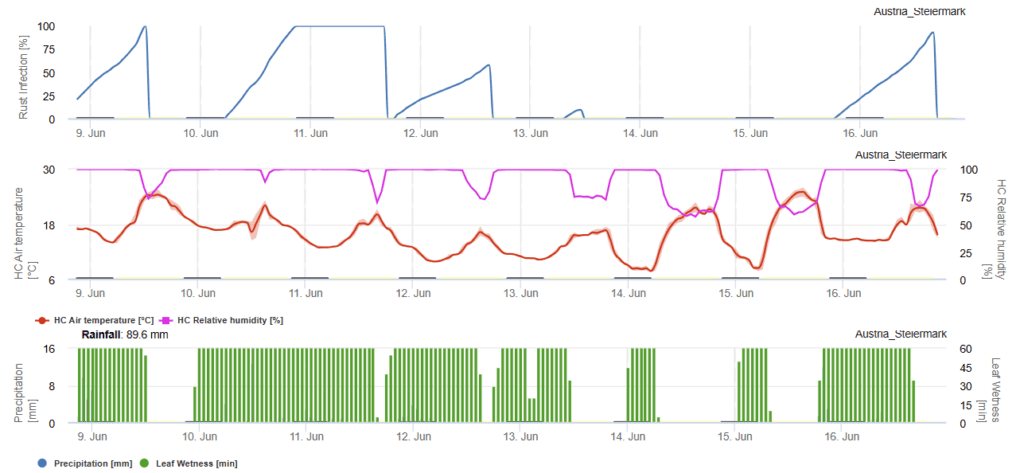
Esporos do agente patogénico fúngico Tranzschelia discolor germinam numa vasta gama de temperaturas, de 5°C a 30°C, com uma gama óptima de 15°C a 25°C em condições de humidade. Em condições controladas, a combinação ideal de duração de humidade e temperatura para a infeção foi encontrada entre 18 e 36 horas a 15°C a 20°C. A gravidade da doença aumenta quando a precipitação ocorre no final da primavera e no verão. Em casos graves, as árvores podem sofrer uma desfoliação rápida devido a infecções pesadas de ferrugem.
Para avaliar o risco de infeção por ferrugem, calculamos um período crítico com base na precipitação, humidade das folhas e temperatura. Quando a curva de infeção atinge 100%, indica que estão reunidas as condições ideais para a infeção da ferrugem no pomar. Nesta altura, devem ser implementadas medidas preventivas de proteção das plantas para mitigar o risco de desenvolvimento de doenças graves.
Literatura
Adaskaveg JE, Soto-Estrada, A, Förster, H, Thompson, D, Hasey, J, Manji, BT, Teviotdale, B. (2000). Ferrugem do pêssego causada por Tranzschelia discolor na Califórnia. Universidade da Califórnia. Agricultura e Recursos Naturais.
Monilinia laxa
Pathogen
Monilinia laxaO fungo da podridão castanha dos frutos de caroço segue um padrão cíclico que assegura a sua persistência e propagação. O fungo hiberna em tecidos vegetais infectados, como galhos, ramos, partes velhas de flores ou frutos mumificados. Na primavera, produz conídios assexuados nestes restos de plantas infectadas. Além disso, estruturas de propagação sexual chamadas apotécios desenvolvem-se em frutos caídos no chão, produzindo ascósporos. Tanto os conídios como os ascósporos são disseminados pelo vento e pela chuva, dando origem a novas infecções em flores e rebentos jovens.
As condições ambientais influenciam significativamente o processo de infeção de Monilinia laxa. O fungo desenvolve-se em clima quente e húmido, com temperaturas óptimas de infeção que variam entre 15°C e 25°C (59°F e 77°F). Conidia começam a desenvolver-se nos restos de plantas infectadas quando as temperaturas atingem os 4°C (40°F), e as infecções ocorrem quando as temperaturas excedem os 10°C (50°F). A humidade elevada e as condições húmidas facilitam a propagação e a germinação dos esporos, tornando os períodos de chuva particularmente propícios ao desenvolvimento da doença.
Sintomas
Os primeiros sintomas de Monilinia laxa A infeção manifesta-se como praga das flores, em que as flores infectadas murcham, ficam castanhas e podem agarrar-se à árvore. Esta praga pode estender-se aos galhos e ramos, levando à formação de cancros - áreas necróticas e encharcadas na madeira. Em condições de humidade, podem formar-se massas de esporos cinzentos-acinzentados a castanhos nas flores doentes e nos galhos, servindo de fontes de inóculo secundário.
À medida que a estação de crescimento avança, o fungo pode infetar os frutos em desenvolvimento, levando à podridão castanha. Os frutos infectados apresentam lesões castanhas, que se expandem rapidamente, frequentemente cobertas por massas de esporos acinzentadas em condições de humidade. Estes frutos podem ficar mumificados e permanecer agarrados à árvore, servindo de reservatórios do agente patogénico. A doença pode causar perdas significativas antes e depois da colheita, especialmente em épocas quentes e húmidas, afectando tanto a produção como a qualidade dos frutos.
Modelo FieldClimate
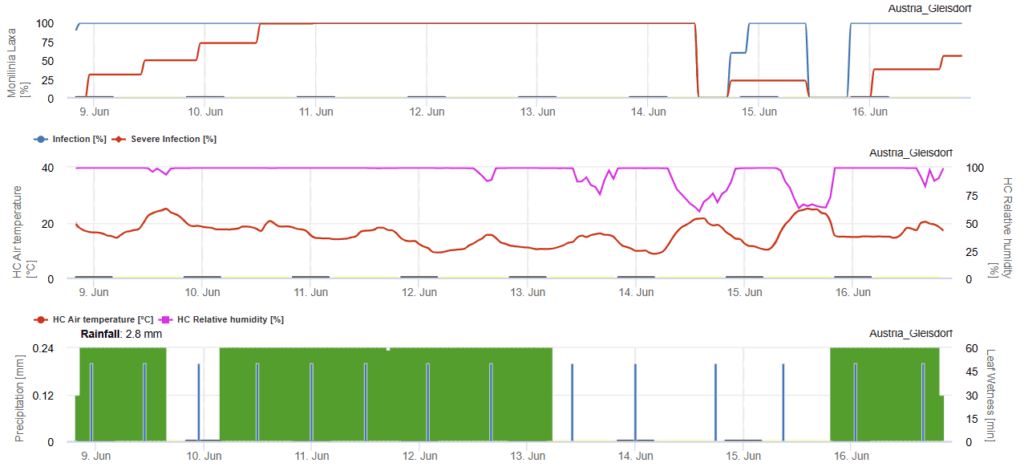
Sensores necessários:
- Temperatura do ar
- Humidade das folhas
- Humidade relativa
- Precipitação
O gráfico ilustra as condições óptimas para Monilinia infecções nos pomares, com base em factores como a humidade das folhas, a temperatura e a humidade relativa. Monilinia laxa está bem adaptado a temperaturas relativamente baixas na primavera e pode causar infecções a temperaturas tão baixas como 5°C, mesmo com um curto período de humidade nas folhas. O nível de infeção 100% no gráfico representa as condições mais favoráveis para o fungo penetrar nos tecidos da planta e iniciar a infeção.
Para apoiar a gestão da doença, devem ser consideradas medidas curativas de proteção das plantas. O gráfico apresenta duas classes de gravidade - infeção e infeção grave - com base em factores como a variedade do fruto, o historial do pomar e a experiência dos agricultores. Estas classificações ajudam a orientar a tomada de decisões para um controlo eficaz da doença.
Literatura
- Casals, C. (2010). Efeito da temperatura e da atividade da água na germinação in vitro de Monilinia spp. Jornal de Microbiologia Aplicada.
- UC IPM. (n.d.). Diretrizes de gestão da UC para a podridão castanha da flor da amendoeira. Victoria, Departamento do Ambiente e das Indústrias Primárias. (n.d.). Brown-rot of stone fruits.
Monilinia spp.
Pathogen
O agente patogénico da podridão castanha, Monilinia spp.O fungo da podridão cinzenta, que afecta os pêssegos e as nectarinas através de um ciclo de vida que começa com a hibernação em frutos mumificados e galhas. Quando as temperaturas sobem na primavera, o fungo produz esporos que infectam as flores e os rebentos jovens, provocando o míldio da flor e os cancros dos ramos. Estas infecções servem de fonte de inóculo para as infecções dos frutos mais tarde na estação. Os frutos maduros tornam-se cada vez mais susceptíveis à podridão castanha, especialmente em condições quentes, húmidas ou molhadas, que favorecem a rápida progressão da doença. As lesões nos frutos, como as causadas por insectos ou granizo, aumentam ainda mais a suscetibilidade. A gestão eficaz inclui práticas culturais, como a remoção de frutos mumificados e galhos com galhos cortados, bem como controlos químicos que envolvem aplicações de fungicidas durante os períodos críticos de floração e pré-colheita.
Sintomas
Monilinia spp. manifesta-se através de vários sintomas distintos. Durante a primavera, as flores infectadas murcham, tornam-se castanhas e podem ficar cobertas de massas de esporos cinzento-acastanhadas, permanecendo muitas vezes presas aos galhos e servindo como fontes de inóculo secundário. A infeção pode estender-se aos ramos, levando à formação de pequenos cancros gomosos que podem cingir e matar os rebentos afectados. Nos frutos maduros, os sintomas iniciais aparecem como pequenas manchas circulares de cor castanha que aumentam rapidamente em condições favoráveis, podendo causar o apodrecimento de todo o fruto em dois dias. Estas áreas apodrecidas desenvolvem frequentemente massas de esporos de cor bronzeada a cinzenta. Os frutos afectados normalmente murcham, tornam-se castanhos a pretos e podem cair no chão ou permanecer mumificados na árvore, contribuindo para a persistência e propagação da doença.
Modelo FieldClimate
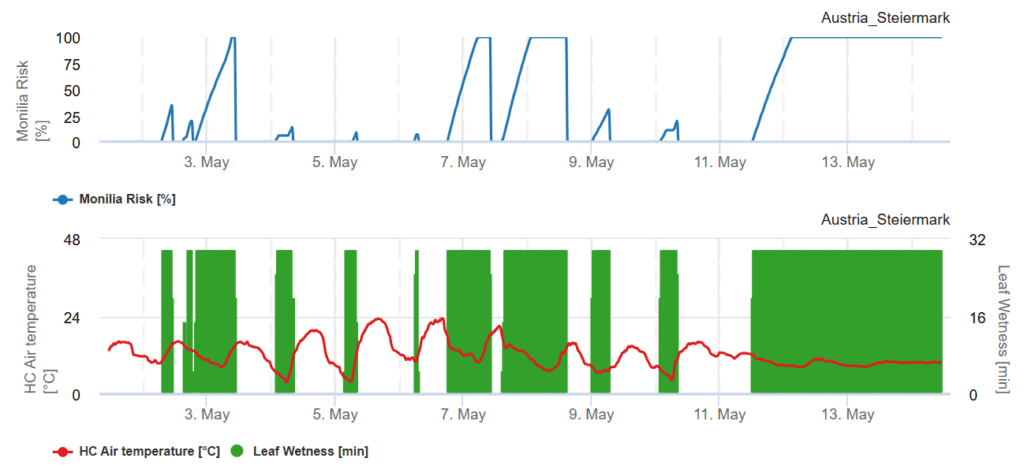
Sensores necessários:
- Temperaturas do ar
- Humidade das folhas
A curva a 100% indica condições óptimas para um Monília infeção nos pomares. Os cálculos baseiam-se na humidade das folhas, na temperatura e na humidade relativa.
Monilia spp. está bem adaptado a temperaturas relativamente baixas durante a primavera e causa infecções a temperaturas tão baixas como 5°C num período muito curto de duração da humidade. A infeção 100% no gráfico indica condições óptimas para o fungo entrar no tecido da planta e causar infecções. As medidas curativas de proteção das plantas têm de ser tidas em conta.
Literatura
- Peter, K. A. (2024, 19 de junho). Doença dos frutos de caroço - Podridão castanha. Penn State Extension. https://extension.psu.edu/stone-fruit-disease-brown-rot
- Biggs, A. R. (2016). Podridão castanha dos frutos de caroço. Ohioline, Extensão da Universidade do Estado de Ohio. https://ohioline.osu.edu/factsheet/plpath-fru-29
Furo de disparo
Pathogen
O fungo do buraco do tiro sobrevive nos botões infectados e pode infetar folhas, caules e frutos durante os períodos frios e chuvosos da primavera e do outono. A chuva é essencial para que o fungo se espalhe e infecte os tecidos saudáveis das plantas.
O fungo pode persistir durante vários anos nos cancros ou nos rebentos dos ramos infectados. Em condições favoráveis, continua a desenvolver-se, mesmo durante o inverno. Na primavera, os conídios são dispersos pela chuva para as flores e folhas jovens, dando início a novas infecções. Em condições desfavoráveis, como o tempo seco, os conídios permanecem viáveis durante vários meses. A chuva é necessária para a dispersão dos esporos, enquanto que as condições de humidade são necessárias para a germinação. O fungo pode desenvolver-se a temperaturas superiores a 2°C.
Quando a humidade é contínua durante, pelo menos, 24 horas e as temperaturas excedem os 2°C, pode ocorrer infeção. À medida que as temperaturas aumentam durante a estação de crescimento, são necessários períodos de humidade mais curtos para a germinação - por exemplo, apenas seis horas a 25°C. Os esporos espalham-se principalmente através de salpicos de água e podem permanecer viáveis durante meses em condições secas. Em condições óptimas, os esporos são produzidos a partir de botões infectados e lesões no caule durante toda a estação de crescimento. A maioria das cultivares de pêssego, nectarina, alperce e amêndoa são altamente susceptíveis, enquanto que a cereja e a ameixa são menos afectadas, apresentando sintomas nas folhas e nos frutos apenas quando ocorrem períodos de humidade prolongados no final da primavera e início do verão.
Sintomas
As folhas infectadas desenvolvem pequenas manchas castanhas com margens avermelhadas, com cerca de 1 mm de diâmetro. Estas manchas expandem-se em lesões circulares maiores, com cerca de 3 mm de diâmetro. À medida que a doença progride, as áreas afectadas secam e caem da folha, criando um aspeto de buraco de bala. Os galhos infectados apresentam margens castanhas distintas com um centro necrótico que não cai, mas exsuda grandes quantidades de goma. Além disso, a lignificação dos galhos infectados é prejudicada e as lesões evoluem gradualmente para cancros. Em casos graves, a doença pode levar à desfoliação prematura da árvore.
Nos frutos, a infeção aparece inicialmente como pequenas manchas circulares de cor púrpura profunda. À medida que a doença progride, os sintomas variam consoante o tipo de fruto. Nos damascos, as manchas tornam-se castanhas, salientes e ásperas, dando ao fruto uma textura de crosta. Nos pêssegos e nas nectarinas, as crostas tornam-se mais profundas, formando reentrâncias pronunciadas. Os frutos infectados desenvolvem frequentemente manchas de goma e, em casos graves, podem formar-se fissuras na pele.
Modelo FieldClimate
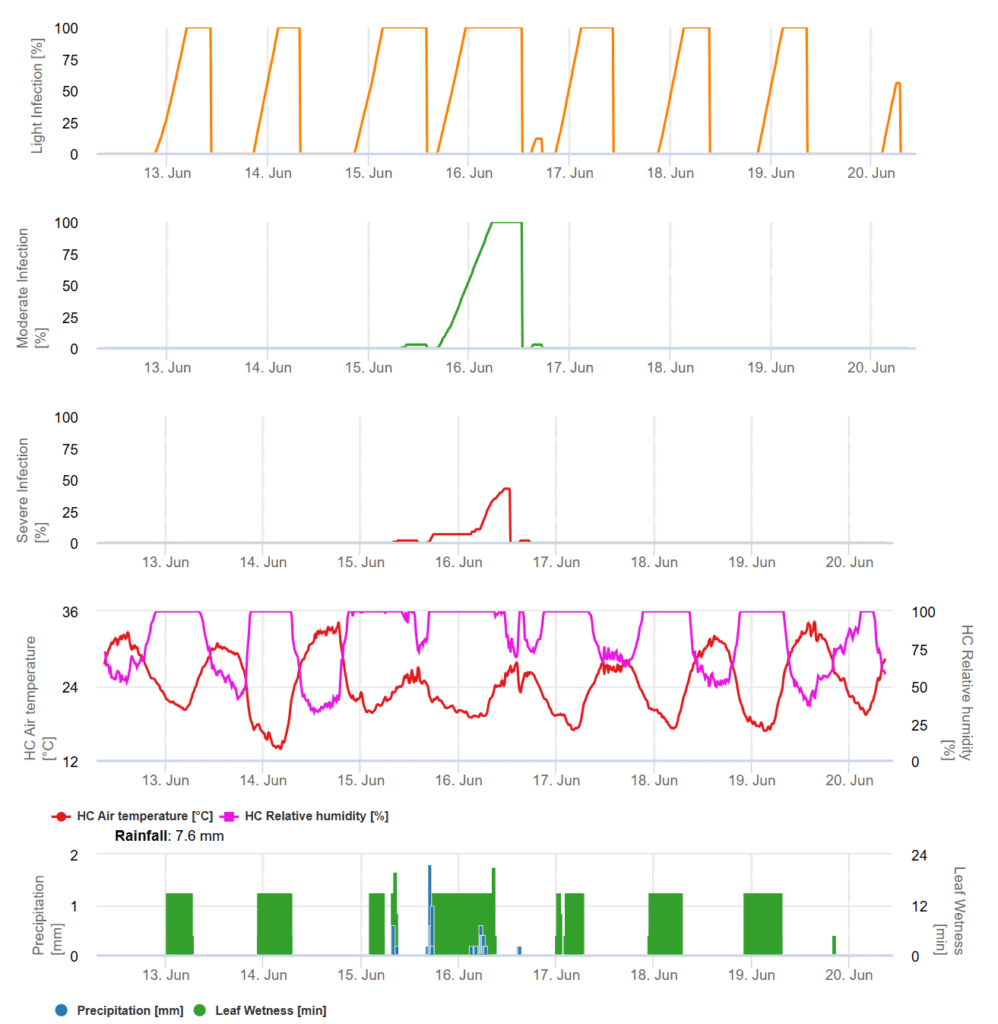
Sensores necessários:
- Temperatura do ar
- Humidade relativa
- Humidade das folhas
- Precipitação
Os períodos de infeção favoráveis para a doença "shot hole" são determinados com base na precipitação, humidade foliar, humidade relativa e temperatura. São avaliados três níveis de gravidade da infeção. As infecções fracas podem começar em condições de humidade relativa elevada e temperaturas quentes. As infecções moderadas e graves são desencadeadas por eventos de chuva e tornam-se mais graves com humidade prolongada das folhas e temperaturas quentes. Uma classificação de infeção 100% na escala indica condições óptimas para a infeção fúngica no campo.
As medidas fitossanitárias devem ser implementadas com base na gravidade da infeção, tendo em conta a experiência anterior, o historial do pomar e a suscetibilidade da variedade de fruto. Devem ser consideradas acções adequadas para níveis de infeção ligeiros, moderados ou graves, a fim de minimizar o impacto da doença.
Literatura
- UC IPM. (n.d.). Doença do Buraco do Tiro / Pêssego / Agricultura. Universidade da Califórnia, Agricultura e Recursos Naturais. Recuperado de https://ipm.ucanr.edu/agriculture/peach/shot-hole-disease/
- Extensão da Universidade Estadual de Utah. (n.d.). Coryneum ou Shothole Blight. Recuperado de https://extension.usu.edu/planthealth/research/coryneum-or-shothole-blight
Xanthomonas arboricola
Pathogen
Xanthomonas arboricola é uma bactéria aeróbica, gram-negativa. A bactéria sobrevive nos espaços intercelulares do córtex, floema e parênquima do xilema do pessegueiro. Nas ameixeiras e damasqueiros, os cancros de verão formam-se numa estação, desenvolvendo-se mais na primavera seguinte e servindo de fonte de inóculo. Além disso, os botões de ameixa e as folhas caídas actuam como fontes de invernada para a doença bacteriana.
Na primavera, as bactérias começam a multiplicar-se, provocando a rutura da epiderme - o que resulta em lesões visíveis conhecidas como cancros de primavera. O inóculo destes cancros é disseminado pela chuva e pelo vento, infectando os tecidos saudáveis das plantas através dos estomas. As lesões desenvolvem-se então nas folhas, exsudando bactérias e conduzindo a infecções secundárias.
Os cancros de verão formam-se no tecido verde do rebento, mas são selados por uma camada de periderme e secam durante o verão, reduzindo a viabilidade bacteriana. Por conseguinte, os cancros de verão em ameixeiras e pessegueiros não são locais significativos de invernada ou fontes de infeção inicial para a estação seguinte. Geralmente, as infecções tardias dos rebentos - que ocorrem durante as chuvas de outono e a queda das folhas - constituem a principal fonte de inóculo para a primavera seguinte.
Sintomas
Nas folhas do pessegueiro, aparecem inicialmente pequenas manchas circulares ou irregulares, de cor verde-pálida a amarela. Estas manchas aumentam e escurecem, tornando-se roxas, castanhas ou pretas. À medida que a doença progride, as áreas afectadas podem cair, dando às folhas um aspeto de buraco de bala, com um anel escuro de tecido doente deixado para trás. As folhas infectadas tornam-se frequentemente amarelas e caem prematuramente. Nos frutos de ameixa, os sintomas variam consoante a cultivar, desde lesões grandes, pretas e afundadas até lesões pequenas, semelhantes a caroços.
Nos ramos de pessegueiro, os cancros primaveris desenvolvem-se nos ramos invernantes e nos rebentos aquáticos antes do aparecimento dos rebentos verdes. Inicialmente, apresentam-se como pequenas bolhas escuras (1-10 cm de tamanho), encharcadas de água, que por vezes cindem o ramo e causam a morte da sua parte superior. Abaixo da zona morta, onde as bactérias estão presentes, forma-se uma faixa escura conhecida como "ponta negra". Nas ameixeiras e nos damasqueiros, os cancros são perenes e continuam a desenvolver-se nos galhos com dois ou três anos de idade.
Modelo FieldClimate
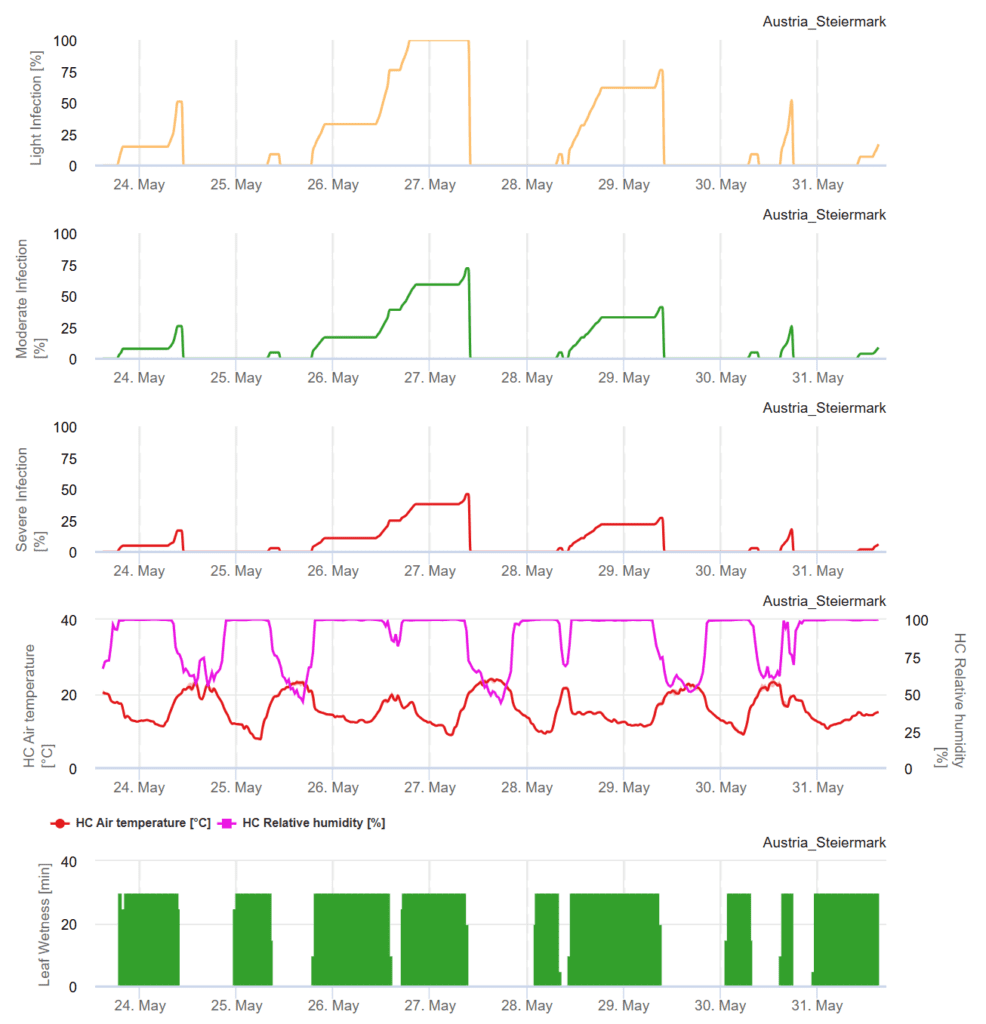
Sensores necessários:
- Temperatura do ar
- Humidade relativa
- Humidade das folhas
A doença bacteriana desenvolve-se em estações quentes, com temperaturas que variam entre 10-28°C, bem como em condições de precipitação ligeira frequente, ventos fortes e orvalho intenso. Nos pomares, a dispersão local ocorre principalmente através de salpicos de chuva.
Classificamos as infecções em três níveis de gravidade: fraco, moderado e grave. A gravidade a considerar depende da quantidade de inóculo presente (com base na epidemiologia do ano anterior), da suscetibilidade da variedade e das condições climatéricas prevalecentes. Um valor de 100% indica condições óptimas para a infeção bacteriana.
Literatura
- EPPO. (2021). PM 7/064 (2) Xanthomonas arboricola pv. pruni. Boletim da OEPP, 51(3), 468-487. https://doi.org/10.1111/epp.12756
- McManus, P. S., & Jones, A. L. (1995). Mancha bacteriana do pêssego e da ameixa. Integrated Pest Management, Michigan State University. https://www.canr.msu.edu/ipm/agriculture/fruit/bacterial_spot_of_peach_and_plum
Taphrina enrolar folhas
Pathogen
Taphrina deformansO fungo da família das doenças do pessegueiro, o agente causador do enrolamento das folhas do pessegueiro, sobrevive sob a forma de esporos nas superfícies das árvores, incluindo a casca e as escamas dos gomos. No início da primavera, durante o inchamento e abertura dos gomos, estes esporos germinam e infectam as folhas emergentes. As condições de tempo fresco e húmido, particularmente as temperaturas quentes acompanhadas de humidade da chuva, orvalho ou irrigação, são ideais para a infeção. Inversamente, o tempo seco durante a abertura e a abertura dos botões limita a ocorrência da doença. À medida que as folhas amadurecem, tornam-se menos susceptíveis à infeção e as infecções secundárias são raras. O fungo produz esporos nas superfícies das folhas infectadas, que são dispersos pela chuva ou pelo vento, alojando-se nas fendas da casca e nas escamas dos gomos para hibernar e perpetuar o ciclo da doença nas estações seguintes.
Sintomas
O agente patogénico induz uma série de sintomas em pêssegos e nectarinas. As folhas infectadas surgem na primavera com espessamento, enrolamento e distorção, frequentemente acompanhadas de descoloração avermelhada ou púrpura. À medida que a doença progride, estas folhas podem tornar-se amarelas ou castanhas e acabar por cair prematuramente, levando a uma potencial desfoliação. Os rebentos infectados podem ficar inchados, atrofiados e podem morrer, especialmente se a infeção for grave. Os sintomas nos frutos incluem manchas elevadas, irregulares e ásperas, frequentemente de cor avermelhada, que podem provocar a queda prematura dos frutos ou torná-los não comercializáveis. Se não forem tratadas, as infecções repetidas podem enfraquecer a árvore, reduzindo a produção de frutos e o vigor geral.
Modelo FieldClimate
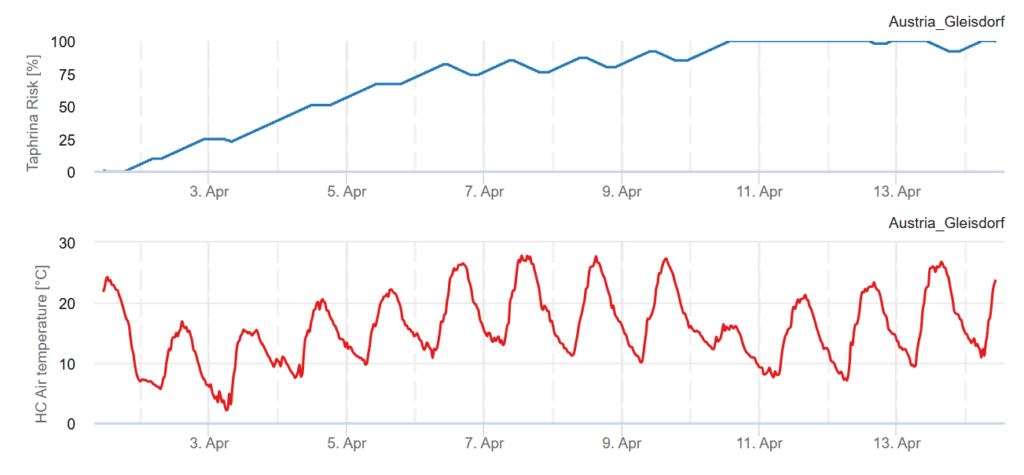
Sensores necessários:
- Temperatura do ar
O gráfico mostra os períodos de risco, com base na temperatura durante esse tempo. O agente patogénico desenvolve-se em temperaturas entre 16 e 27 °C. O gráfico indica que em 100% as temperaturas óptimas foram atingidas durante tempo suficiente para um evento de infeção do agente patogénico.
Literatura
- Biggs, A. R. (2016). Caracol da folha do pessegueiro. Ohioline, Extensão da Universidade do Estado de Ohio. https://ohioline.osu.edu/factsheet/plpath-fru-26
- Universidade da Califórnia, Agricultura e Recursos Naturais. (n.d.). Caracol da folha do pessegueiro. UC IPM Pest Notes. Recuperado em 6 de março de 2025, de https://ipm.ucanr.edu/home-and-landscape/peach-leaf-curl/pest-notes/
Pó de oídio
Pathogen
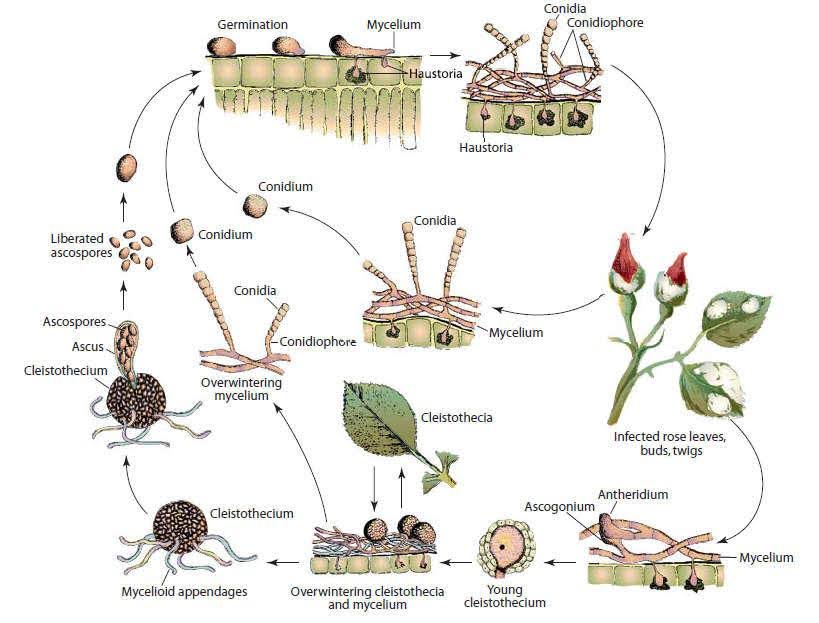
O agente patogénico é Sphaerotheca pannosa. Inverte sob a forma de micélios em gomos infectados ou cleistoteca e servem como inóculo primário.
Conidia (esporos assexuados) e ascósporos (esporos sexuais) são produzidos pelo micélio e pelo cleistotécio, respetivamente. São transportados pelo vento até às plantas susceptíveis e, uma vez pousados, germinam e produzem um tubo germinativo que forma hifas, propagando a infeção. As infecções secundárias ocorrem principalmente através de conídios. Os fungos produzidos pelas infecções primárias e subsequentes são transportados pelo vento e pela chuva, dando continuidade à infeção. Quando as condições ambientais se tornam adversas, o fungo passa a reproduzir-se principalmente por via sexual e o ciclo repete-se.
Sintomas
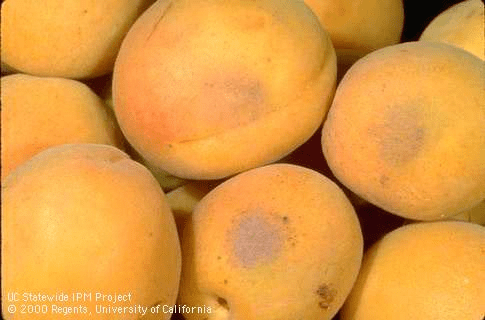
Inicialmente, aparecem bolhas nas áreas afectadas, que logo ficam cobertas de micélio pulverulento branco a acinzentado e esporos. Esta infeção fúngica provoca a distorção das folhas, o seu enrolamento e a sua queda prematura. Os botões e as flores também são vulneráveis; podem não abrir corretamente e apresentar descoloração e crescimento atrofiado. Além disso, os frutos são altamente susceptíveis - podem desenvolver manchas ásperas e cortiça que se tornam rosa a castanho-escuro na sua pele e o epicarpo torna-se coriáceo e duro.
Modelo FieldClimate
Modelo geral de risco da Sphaerotheca pannosa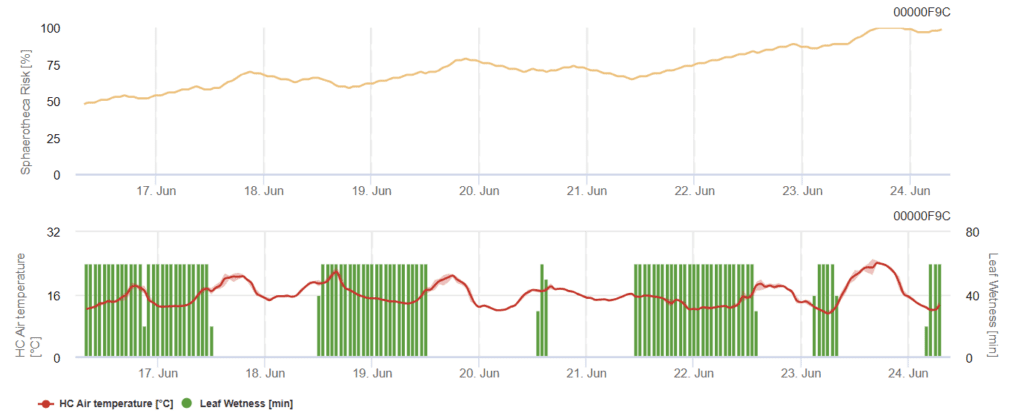
Sensores necessários:
- Temperatura do ar
- Humidade das folhas
O modelo considera as temperaturas do ar e a duração da humidade das folhas para calcular o risco. A temperatura óptima varia entre 21 e 27'c e o desenvolvimento da doença torna-se mais lento a temperaturas superiores a 28'c. Uma vez que os esporos e o micélio são sensíveis ao calor extremo e à luz solar direta, as temperaturas moderadas e quentes e a sombra são geralmente favoráveis. Não é necessária qualquer humidade para que o fungo se estabeleça e cresça após a infeção. Formam-se muito mais conídios em condições secas do que em condições húmidas.
Um valor superior a 60% indica um risco elevado de infeção, devendo ser consideradas medidas de proteção das plantas.
Literatura
- Domínguez-Serrano, D., García-Velasco, R., Mora-Herrera, M. E., Salgado-Siclan, M. L., & Gonzalez-Diaz, J. G. (2016). O oídio da rosa (Podosphaera pannosa). Agrociência, 50(7), 901-917.
- Mulbrhan, A., Brikity, A., Yohana, S. R., & Danish, S. (2016). Levantamento da Incidência de Doenças e Gravidade do Oídio em Rosas (Rosa Sinensis L.) em Estufas em Maisirwa, Eritreia. Jornal Asiático de Ciência e Tecnologia, 7(5), 2850-2856.
- Ram, V., & Bhardwaj, L. N. (2004). Doenças dos frutos de caroço e sua gestão. Em Doenças de Frutas e Legumes: Volume II: Diagnóstico e Gestão (pp. 485-510). Dordrecht: Springer Netherlands.
- Yarwood, C. E., Sidky, S., Cohen, M. O. R. R. I. S., & Santilli, V. I. N. C. E. N. T. (1954). Relações de temperatura do oídio. https://ipm.ucanr.edu/home-and-landscape/powdery-mildew-on-fruits-and-berries/pest-notes
Modelo de sarna de fruta com caroço
Pathogen
Cladosporium carpophilumO fungo da sarna do pessegueiro, o agente causador da sarna do pessegueiro, sobrevive principalmente como micélio em lesões nos galhos dos rebentos da estação anterior. Na primavera, quando a humidade excede 70%, o fungo produz conídios (esporos assexuados) nessas lesões. Estes esporos são disseminados pelo movimento do ar e por salpicos de água, infectando frutos em desenvolvimento, novos rebentos e folhas. As condições ideais para a germinação dos esporos e o crescimento do fungo ocorrem a temperaturas entre 18°C e 24°C (65°F e 75°F), com a chuva e a humidade elevada a facilitar a infeção. É de salientar que existe um período de incubação prolongado de aproximadamente 40 a 70 dias antes de os sintomas se tornarem visíveis nos frutos.
Sintomas
A doença manifesta-se como pequenas manchas aveludadas, de cor azeitona a preta, nos frutos, frequentemente mais graves perto da extremidade do pedúnculo. Estas lesões podem coalescer, dando origem a áreas doentes maiores e a potenciais fissuras nos frutos. Nos ramos e rebentos, as infecções aparecem como lesões castanhas ligeiramente elevadas, redondas a ovais, com margens roxas, mais tarde na estação. Embora as infecções nas folhas sejam menos comuns, podem ocorrer em condições favoráveis. As infecções graves podem resultar numa redução da qualidade e do rendimento dos frutos, o que sublinha a importância de práticas de gestão eficazes.
Modelos FieldClimate
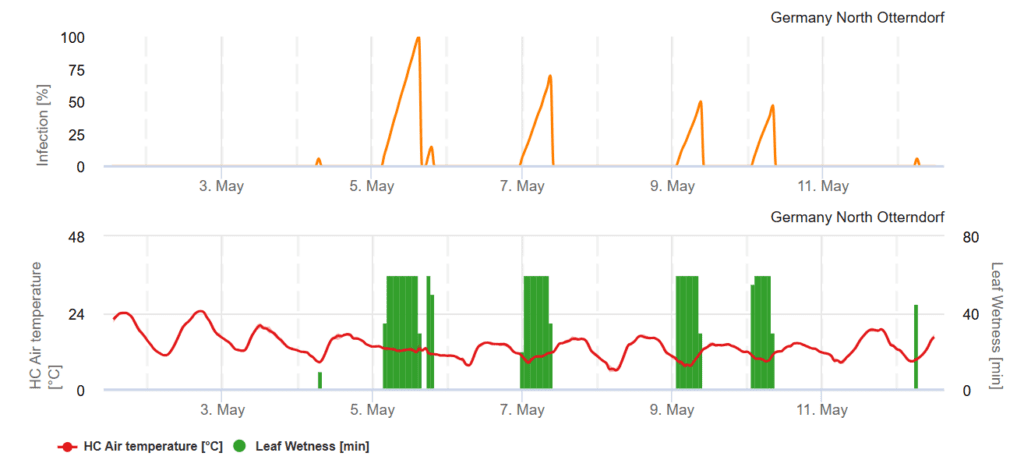
Sensores necessários:
- Temperatura do ar
- Humidade das folhas
O risco de um Cladosporium carpophilum A infeção é determinada por condições de humidade durante a primavera e o início do verão, após a queda das pétalas. A doença é geralmente mais grave em zonas baixas, sombrias e húmidas, com pouco movimento de ar. As curvas de infeção aumentam durante os períodos de humidade das folhas dentro de um intervalo de temperatura de 7 a 24°C e, com um risco de 100%, foram dadas as condições ideais para o fungo entrar no tecido da planta. Medidas curativas de proteção das plantas devem ser consideradas após um risco de 100%.
Literatura
- Ellis, M. A. (2016). Sarna do pêssego, da nectarina, da ameixa e do alperce. Ohioline. Recuperado de https://ohioline.osu.edu/factsheet/plpath-fru-39
- Garofalo, E. (2020). Sarna do pêssego. Guia de gestão das árvores de fruto da Nova Inglaterra. Recuperado de https://netreefruit.org/stone-fruit/peaches-nectarines/diseases/peach-scab
Equipamento recomendado
Verificar que conjunto de sensores é necessário para monitorizar as potenciais doenças desta cultura.
